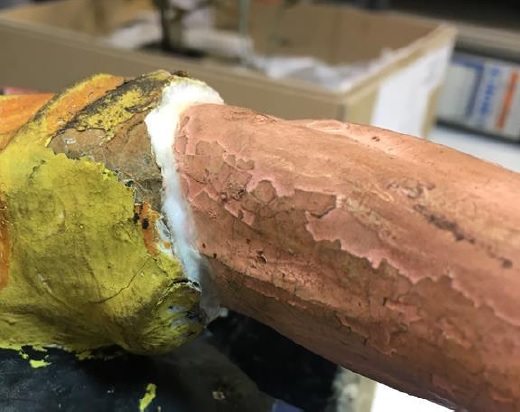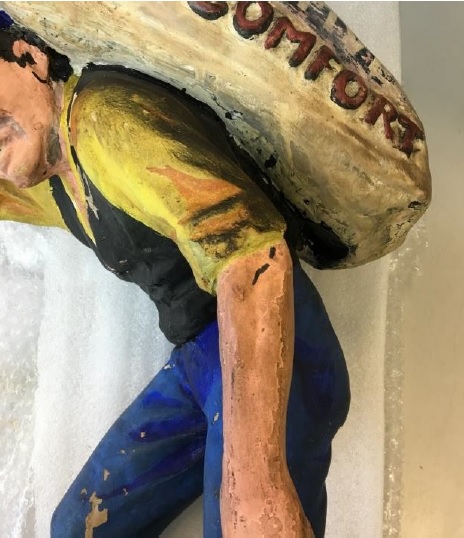May ’19

Coal Man Figure
May’s ‘Object of the Month’ is papier-mâché figure of a man carrying a bag of coal on his back from the collections at Beamish Museum. The bag reads ‘Co-operative’ and underneath ‘Coal for Comfort’.

The object was purchased from a farmer near Seaham in 2003, however it is unclear where it was originally purchased. Since the collieries were nationalised on the 1st January 1947, which means they were taken over by the government from private companies, it is safe to assume that the object is pre 1947 as there won’t be adverts for private coal after that date. It is difficult to know when exactly the object was produced, however it was likely during the early 20th century.

The coal mining industry has played an essential role in British history as it has been a main source of fuel for hundreds of years. 1913 is considered to be the peak year of coal production in Britain comprising of 287 million tons. The British mining communities, particularly those in the north of England, were among the earliest supporters of what was known as the Rochdale Co-Operative system. Rochdale, a small Lancashire cotton town, established its model co-operative society in 1884. This model followed the principle of buying the best quality goods at wholesale prices, and then selling them to members at the current retail price.

The ‘Coal for Comfort’ Coal Man figure holds an educational and a historical value. It is representing a period of time when the coal mining industry had fuelled the Britain Isles. At its peak, the British coal industry employed over a million men and was one of the most important industries in the UK. The object also signifies the important role of the Co-operative wholesale societies (CWS) formed in 1863 by the Rochdale Pioneers in Britain. The Co-operative logo on the sack of the coal man indicates that the Co-operative shops sold coal and advertised it by displaying this type of figure.
Conservation

As the paint on the coal man figure was susceptible to solvents, wet cleaning methods weren’t considered. As such, the figure was first lightly brushed and vacuumed in order to remove the bulky surface dirt and cobwebs. Following this, alternative dry cleaning methods were tested in order to determine which would be the most effective method for removing the remainder of the surface dirt. Akapad was used to remove dirt from the wooden plinth, while smokesponge was most effective on the figure itself. Finally a handheld eraser was used to remove the pencil marks on the figure’s trousers.

During surface cleaning it was clear that some areas of the paint were loose, flaking or had been lost entirely. As such it was determined that consolidation of these areas would be beneficial to avoid further paint loss. The paint was tested for solubility so an appropriate consolidant could be chosen and was found not to be soluble in ethanol, white spirit and toluene. As such a suitable consolidant was found that stabilised the paint and gave a matt finish, which would blend better with the rest of the object. The consolidant was applied to the surface using a combination of brushing and injecting in order to fully penetrate the layers.

To repair the proper left arm of the coal man figure, comparative treatments were researched in order to determine which would be most effective. As such, a combination of paper pulp and an appropriate adhesive were selected, which would provide strength and support to the arm. The paper pulp and adhesive mix was carefully applied to the inside of the break edge as well as the outside in order to build up the thickness and provide additional strength. The repair was slowly built up until it was at the same level as the sleeve and once cured was colour matched in order to minimise the obtrusiveness of the repair.

This same treatment was applied to the crack on the proper left foot, as well as the gap between the feet and plinth, which was partially causing the figure to be unstable. Finally a small piece of black plastazoate was adhered to the underside of one corner of the plinth in order to provide additional stability and to prevent the figure from toppling over.
Stay tuned for next month’s object!
